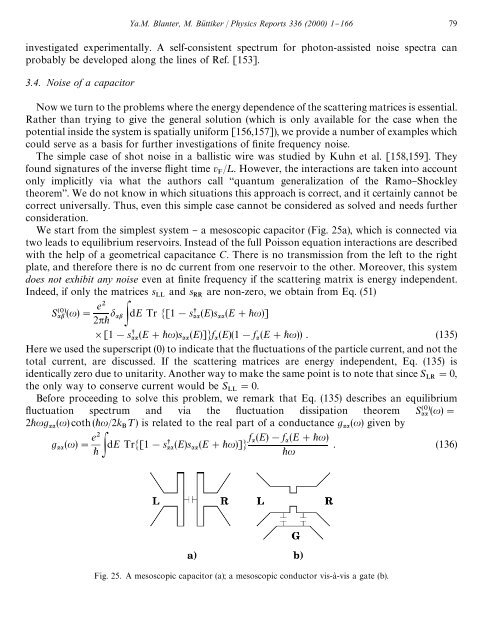shot noise in mesoscopic conductors - Low Temperature Laboratory
shot noise in mesoscopic conductors - Low Temperature Laboratory
shot noise in mesoscopic conductors - Low Temperature Laboratory
Create successful ePaper yourself
Turn your PDF publications into a flip-book with our unique Google optimized e-Paper software.
<strong>in</strong>vestigated experimentally. A self-consistent spectrum for photon-assisted <strong>noise</strong> spectra can<br />
probably be developed along the l<strong>in</strong>es of Ref. [153].<br />
3.4. Noise of a capacitor<br />
Ya.M. Blanter, M. Bu( ttiker / Physics Reports 336 (2000) 1}166 79<br />
Now we turn to the problems where the energy dependence of the scatter<strong>in</strong>g matrices is essential.<br />
Rather than try<strong>in</strong>g to give the general solution (which is only available for the case when the<br />
potential <strong>in</strong>side the system is spatially uniform [156,157]), we provide a number of examples which<br />
could serve as a basis for further <strong>in</strong>vestigations of "nite frequency <strong>noise</strong>.<br />
The simple case of <strong>shot</strong> <strong>noise</strong> <strong>in</strong> a ballistic wire was studied by Kuhn et al. [158,159]. They<br />
found signatures of the <strong>in</strong>verse #ight time v /¸. However, the <strong>in</strong>teractions are taken <strong>in</strong>to account<br />
<br />
only implicitly via what the authors call `quantum generalization of the Ramo}Shockley<br />
theorema. We do not know <strong>in</strong> which situations this approach is correct, and it certa<strong>in</strong>ly cannot be<br />
correct universally. Thus, even this simple case cannot be considered as solved and needs further<br />
consideration.<br />
We start from the simplest system } a <strong>mesoscopic</strong> capacitor (Fig. 25a), which is connected via<br />
two leads to equilibrium reservoirs. Instead of the full Poisson equation <strong>in</strong>teractions are described<br />
with the help of a geometrical capacitance C. There is no transmission from the left to the right<br />
plate, and therefore there is no dc current from one reservoir to the other. Moreover, this system<br />
does not exhibit any <strong>noise</strong> even at "nite frequency if the scatter<strong>in</strong>g matrix is energy <strong>in</strong>dependent.<br />
Indeed, if only the matrices s and s are non-zero, we obta<strong>in</strong> from Eq. (51)<br />
<br />
e<br />
S()"<br />
2 dE Tr [1!s (E)s (E#)]<br />
[1!s (E#)s (E)]f (E)(1!f (E#)) . (135)<br />
<br />
Here we used the superscript (0) to <strong>in</strong>dicate that the #uctuations of the particle current, and not the<br />
total current, are discussed. If the scatter<strong>in</strong>g matrices are energy <strong>in</strong>dependent, Eq. (135) is<br />
identically zero due to unitarity. Another way to make the same po<strong>in</strong>t is to note that s<strong>in</strong>ce S "0,<br />
<br />
the only way to conserve current would be S "0.<br />
<br />
Before proceed<strong>in</strong>g to solve this problem, we remark that Eq. (135) describes an equilibrium<br />
#uctuation spectrum and via the #uctuation dissipation theorem S<br />
()"<br />
2g () coth (/2k ¹) is related to the real part of a conductance g () given by<br />
<br />
g ()"<br />
e<br />
dE Tr[1!s (E)s (E#)] f (E)!f (E#)<br />
. (136)<br />
<br />
Fig. 25. A <strong>mesoscopic</strong> capacitor (a); a <strong>mesoscopic</strong> conductor vis-à-vis a gate (b).
















